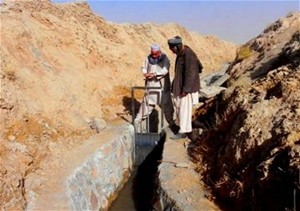
Members of the community in Shindand District in Herat Province watches as the karez is closed. This stops the water from flowing onward as it has for centuries, backing it up to its underground source.
USAID/AWATT
Farmers watched the closure of karez in Shindad District in amazement
3 FEBRUARY 2011 | HERAT PROVINCE, AFGHANISTAN
Karezes have been around for about 3,000 years, stretching from China to Africa. A karez is a unique way of gathering water which flows continuously all year through underground tunnels and the farmers have little control of the discharge rate. It flows fast in the spring, just after the snowmelt, and the flow gradually declines to a minimum at the end of fall, before the annual precipitation season. The karez flow is high for three to four months during the winter and much water goes to waste. In the summer growing months the karez flows even at night when the farmers don’t irrigate, again, going to waste.
Lining the Karez Bibi in Shindand District, Herat Province, by the Afghanistan Water, Agriculture and Technology Transfer (AWATT) Project has made it possible to install a gate at the end of the tunnel and either shut the karez down when the water is not needed, or regulate the flow to match the irrigation demand. This essentially transforms the karez into an underground reservoir, similar to a dam, but more effective as the underground reservoir does not evaporate or seep out. This has never been done before.
When the project engineer, Zohrab Samani, proposed closing the canal, the reaction was skepticism. The contractor and farmers in the community were certain that if the tunnel exit were closed, the water would naturally just overflow the top of the gate. But on December 15, 2010, they watched with amazement as the gate was closed and the flow stopped. This may well be the greatest improvement in the karez system in its 3,000 year history. Until now, closing down the karez was considered to be impossible by most people.
The purpose of lining the karez was to reduce the work required to clean the karezes each year and to create a sustainable water source for the farmers in Shindand District. It is estimated that the improvements in karez engineering have added 8,000 ha of irrigated land to 12 villages, impacting the lives of more than 117,000 people and providing new farm employment to about 120,000 people. But the most significant achievement of the project was giving the farmers the control over when to use their water by shutting down, or regulating the karez.







Comment
Make a general inquiry or suggest an improvement.